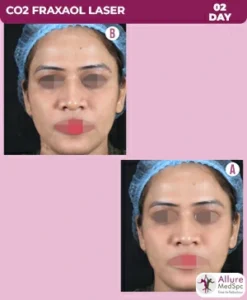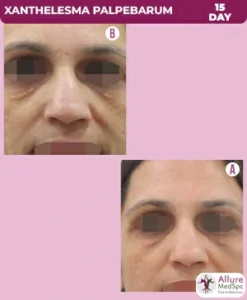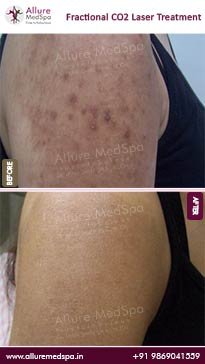Fractional CO2 Laser Treatment in Mumbai – Renew, Resurface, Rejuvenate
Rediscover Radiant, Youthful Skin with Fractional CO2 Laser Treatment
Do acne scars, wrinkles, or dull skin make you feel less confident about your appearance?
Have years of sun exposure, pollution, or stress left your skin looking tired and uneven?
Do you find that no matter how many skincare products you try, the results never last? These visible imperfections can impact more than just your skin—they can affect how you feel about yourself every day.
It’s time to change that.
Fractional CO2 Laser Treatment is a breakthrough in skin rejuvenation technology that penetrates deep into the skin to repair, renew, and restore. By stimulating collagen production and resurfacing damaged layers, this advanced treatment helps fade acne scars, smooth fine lines, reduce pigmentation, and improve skin texture—all while enhancing your natural glow. It’s safe, minimally invasive, and clinically proven to deliver dramatic, long-lasting results.
Global & Indian Statistics (ISAPS 2024)
- Globally, over 957,435 laser skin resurfacing procedures were performed in 2024, marking a 19.3% increase from the previous year.
- India ranked among the top 10 countries globally, with a significant rise in demand for Fractional CO2 Laser Treatments—especially for acne scar and anti-aging concerns.
Source: ISAPS Global Survey 2024
What Is Fractional CO2 Laser Treatment?
Fractional CO2 Laser Treatment is an advanced form of laser resurfacing that uses a precise carbon dioxide laser to remove damaged skin layers and stimulate collagen regeneration. This procedure effectively targets deep acne scars, wrinkles, fine lines, and pigmentation irregularities, revealing smoother, firmer, and more youthful-looking skin. It’s a non-surgical treatment with minimal downtime and long-lasting rejuvenation.
Synonyms of Fractional CO2 Laser Treatment:
- CO2 laser resurfacing
- Carbon dioxide laser
- Fractional resurfacing
- Ablative laser skin resurfacing
- Laser peeling treatment
Fractional Laser Before and After Images
Fractional CO2 Laser Treatment Testimonials: Fine To Fabulous Journeys
Awarded by Google.com
Rating: 4.7
Reviews: 485+
Awarded by WhatClinic.com
Rating: 4.8
Reviews: 119+
Awarded by Realself
Rating: 4.9
Reviews:453+
Awarded by Facebook
Rating: 4.6
Reviews:105+
What are some Quick Facts about Fractional CO2 Laser Treatment?
CO2 laser treatment for skin rejuvenation is a trusted and FDA-cleared method for improving skin texture.
- Treatment time: 15–30 minutes
- Recovery: 1–2 weeks
- Results: Visible after 1 session
- Areas treated: Face, neck, arms, hands
- Pain: Mild with numbing cream
What are the Benefits of Fractional CO2 Laser Treatment?
Fractional CO2 laser is a versatile skin resurfacing treatment known for its precision and ability to treat a wide range of skin concerns with minimal invasiveness. It offers both cosmetic and medical advantages.
Key Benefits of CO2 Laser Treatment
- Targets both pigmented and non-pigmented lesions (not pigment-selective)
- Delivers tissue-selective, high-precision results for smoother skin
- More affordable due to low-cost consumables
- Minimally invasive compared to chemical peels or dermabrasion
- Faster recovery with a short downtime of around 2 weeks
Who is a Good Candidate for Fractional CO2 Laser Treatment?
If you’re seeking non-surgical acne scar removal or wrinkle reduction, this treatment could be for you.
- Adults aged 25–55 with mild to moderate aging
- Those without open wounds or skin infections
- Not using isotretinoin or photosensitizers
- Willing to follow dermatologist-advised aftercare
Who Should Stay Away from Fractional CO2 Laser Treatment?
Fractional CO2 laser treatment is not suitable for everyone, especially those with certain skin or medical conditions. A professional consultation is essential to ensure your safety and suitability.
People Who Should Avoid This Treatment
- Individuals with active acne breakouts, open wounds, or facial infections
- Those currently taking oral isotretinoin (e.g., Accutane)
- Patients with poor wound healing or a history of keloid scarring
- People with chronic illnesses such as uncontrolled diabetes
- Anyone with a compromised immune system or undergoing radiation/chemotherapy
Important Note
- Always consult a certified dermatologist to evaluate your skin condition, medical history, and overall suitability for CO2 laser therapy.
- A professional evaluation helps minimize risk and ensure optimal results.
Why Should You Consult with a Dermatologist?
A consultation with a board-certified dermatologist is essential to accurately diagnose your skin concerns and determine whether fractional CO2 laser treatment is right for you. Personalized care ensures both safety and optimal results.
What a Dermatologist Helps You With
- Diagnoses the root cause of your skin issue
- Evaluates if you’re a suitable candidate for fractional CO2 laser treatment
- Creates a custom treatment plan based on your skin type, condition, and history
- Ensures the procedure is done safely, effectively, and ethically
- Helps avoid risks if you have pre-existing conditions or past treatments
Before Treatment, Be Sure to:
- Share details of any past skin procedures or medications
- Inform your dermatologist of active infections, allergies, or sensitivities
- Ask questions about expected outcomes, downtime, and aftercare
One expert consultation can dramatically improve your treatment success and long-term skin health. Always choose a board-certified dermatologist for laser-based procedures.
What should be done before the procedure?
Prepping your skin helps maximize safety and results.
- Avoid sun exposure for 2 weeks
- Discontinue retinol and exfoliants
- Stop blood thinners (if advised)
- Follow dermatologist-recommended skincare prep
How is the Procedure for Fractional CO2 Laser Done?
Fractional CO2 laser treatment is a quick, minimally invasive skin-resurfacing procedure performed under topical anesthesia. It requires some pre-procedure care to ensure safety and optimal results.
Pre-Treatment Guidelines (Start 2 Weeks Before)
- Avoid retinol-based skincare products
- Stay out of direct sun exposure
- Do not take aspirin, ibuprofen, or vitamin E, as they can increase bleeding risk
- Stop smoking at least 2 weeks before and after treatment to promote healing
Step-by-Step Process
- Topical anesthetic cream is applied 30–45 minutes before treatment to minimize discomfort
- The treatment area is cleansed to remove oil, dirt, and bacteria
- The fractional CO2 laser is applied in a scanning pattern to remove damaged outer skin layers
- The laser creates microthermal zones that trigger collagen production and natural skin regeneration
- Post-treatment, the area is covered with wraps or dressings to protect healing skin
How Does a Fractional CO2 Laser Work?
I am text block. Click edit button to change this text. Lorem ipsum dolor sit amet, consectetur adipiscing elit. Ut elit tellus, luctus nec ullamcorper mattis, pulvinar dapibus leo.
What is the After Care Procedure for Fractional CO2 Laser Treatment?
Aftercare is essential to promote healing and avoid complications after fractional CO2 laser treatment. Here’s what you should follow to get the best results:
Daily Skin Care Instructions
- Use SPF 50+ sunscreen every day—even when indoors or on cloudy days.
- Avoid harsh products; instead, use a gentle cleanser and moisturizer twice daily.
- Minimize or skip makeup to prevent irritation during recovery.
- Clean the treated area 2 to 5 times a day using:
- Saline solution
- Vinegar-based solution (as recommended by your doctor)
- Apply new, sterile dressings daily to keep the skin clean.
First 24–48 Hours Care
- Apply an ice pack or cold compress to reduce facial swelling.
- Use healing ointment as advised to prevent scabbing.
Activities to Avoid
- No sun exposure, steam rooms, or saunas.
- Avoid strenuous workouts and swimming pools.
- Refrain from makeup and harsh skincare for at least 7–10 days.
What is the Recovery Time after Getting Fractional CO2 Laser Treatment?
Fractional CO2 laser treatment typically requires a recovery time of 3 to 10 days, depending on the depth and size of the treated area. While it’s not surgery, proper aftercare and downtime are essential for safe skin healing and best results.
Recovery Timeline & What to Expect
- Mild treatments: 3–7 days of redness, peeling, and flaking
- Moderate-to-deep treatments: Up to 2–3 weeks for full recovery
- Ablative procedures may cause scabbing, swelling, and extended redness
- Peeling and flaking are normal signs of skin regeneration
- Ice packs can help reduce swelling in the first 24–48 hours
Important Aftercare Reminders
- Avoid germ-prone environments like gyms or public pools
- Keep the skin clean with doctor-recommended solutions
- Use sun protection and avoid harsh skincare until fully healed
How Long Does It Take to See the Results of Fractional CO2 Laser Treatment?
Results from fractional CO2 laser treatment can begin appearing within a few days to weeks, depending on the skin concern being treated. Long-term improvements continue to develop as collagen rebuilds.
When to Expect Visible Results
- Hyperpigmentation: Noticeable improvement often seen after just 1 session
- Acne scars and fine lines: Results may take 2–3 weeks to appear and continue improving for up to 6 months
- Severe skin concerns: May require multiple sessions for optimal outcomes
Ablative vs. Non-Ablative Differences
- Ablative (like CO2):
- More intense with visible results after 1 session
- Requires downtime but offers deeper skin resurfacing
- Non-ablative (like IPL):
- Gentler and less downtime
- Multiple sessions often required for visible results
How Long Do Results Last?
- Final results can last several years with good skincare
- Not permanent – touch-up treatments may be needed over time
What are the Side Effects of Fractional CO2 Laser Treatment?
Fractional CO2 laser treatment can cause temporary skin reactions as it works by heating deep layers of skin to promote regeneration. Most side effects are mild and manageable.
Common and Possible Side Effects
- Redness or swelling in the treated area
- Scabbing or mild peeling during healing
- Discomfort or tingling sensation in the first few days
- Dryness or flakiness due to skin renewal
Rare but Serious Reactions
- Hyperpigmentation (dark spots)
- Infection (especially if post-care is not followed)
- Prolonged redness lasting more than 10–14 days
Minimizing Risk
- Follow your dermatologist’s post-care instructions strictly
- Avoid sun exposure, harsh skincare, and touching the treated area
- Use prescribed ointments and moisturizers consistently
What is the Cost of Fractional CO2 Laser Treatment in Mumbai, India?
The cost of fractional CO2 laser treatment in Mumbai ranges between ₹3,000 and ₹8,000 per session, depending on the skin concern, treatment area, and whether additional therapies like PRP are included.
Cost Breakdown
- Per session cost: ₹3,000 – ₹8,000
- Total sessions needed: Usually 3 to 6 sessions based on skin condition severity
- Add-on treatment: PRP (Platelet-Rich Plasma) may be suggested for faster healing and better results, at an extra cost
Why Choose Allure Medspa?
- Offers internationally accredited technology and techniques
- Known for affordable, ethical, and transparent pricing
- Customized treatment plans with consultation support from expert dermatologists and cosmetologists
Who is the Best Doctor for Fractional CO2 Laser Treatment in Mumbai?
For safe, effective, and personalized CO2 laser treatments in Mumbai, Dr. Milan Doshi is widely recognized as a trusted expert in the field of cosmetic dermatology and laser procedures. With years of experience and thousands of successful outcomes, he combines precision with patient-first care.
Why Choose Dr. Milan Doshi?
- Board-certified cosmetic surgeon with 25+ years of experience
- Treated thousands of patients, including Bollywood celebrities and international clients
- Renowned for accurate diagnosis and customized treatment planning
- Expertise in Fractional CO2 laser, chemical peels, microdermabrasion, PRP, and more
- High patient satisfaction rate with proven aesthetic results
- Known for his ethical practice and transparent communication
“ Meet Celebrity Cosmetic Surgeon”
Which is the Best Cosmetic clinic Centre
for Fractional CO2 Laser Treatment?
Allure Medspa in Mumbai, India, is one of the most trusted and advanced centers for fractional CO2 laser treatments, offering state-of-the-art technology, expert care, and customized treatment plans under one roof.
Why Allure Medspa Stands Out
- Equipped with world-class cosmetic laser technology
- Led by Dr. Milan Doshi, a board-certified cosmetic surgeon with 25+ years of experience
- Offers a comprehensive range of treatments—from fractional CO2 laser to surgical stretch mark removal
- NABH-accredited surgical facility with the highest safety protocols
- Delivers personalized care for every skin concern—pigmentation, scars, wrinkles, or stretch marks
What You Can Expect
- Tailor-made treatment plans to match your skin type and goals
- Transparent pricing and ethical consultation
- International patients welcomed, with special assistance for travel & stay
- Full spectrum of skin and body procedures—all under one roof
Ready to begin your skin transformation journey?
Consult the experts at Allure Medspa by
booking your appointment here and experience the difference.
(FAQs) Frequently Asked Question About Fractional CO2 Laser Treatment
Q1. Does CO2 fractional laser really work?
Yes, it’s clinically proven to improve skin quality and reduce scars with visible results.
Q2. How many sessions are needed?
Usually 3–6 sessions, spaced 4–6 weeks apart, depending on severity.
Q3. Is it painful?
Only mildly uncomfortable. A numbing cream is applied beforehand for a nearly painless experience.
Q4. Does the skin regrow?
Yes. The outer skin layer sheds and regrows naturally, appearing clearer and smoother.
Q5. Can it treat deep acne scars?
Absolutely. It’s one of the best lasers for acne scars and collagen regeneration.
Q6. When can I wear makeup again?
Wait 7–10 days post-treatment or until peeling stops.
Q7. Can CO2 laser tighten skin?
Yes. It stimulates collagen production and improves skin elasticity.
Q8. Will my skin peel after treatment?
Yes, typically starting on Day 2 and lasting about 5–7 days.
What is the Medical Code for Fractional CO2 Laser?
| CPT Code | Description | ICD-10 Code |
|---|---|---|
| 17110 | Destruction of benign skin lesions via laser therapy | Z41.1 |
Related Links
Note: The author of this content is Dr. Milan Doshi, An Indian board-certified plastic & cosmetic Surgeon wholly & solely confirms the authenticity of the information & knowledge delivered by this write-up.











